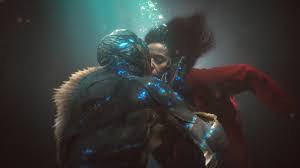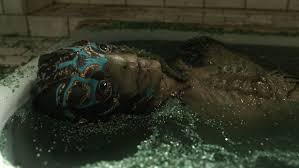
Think Grimm’s Fairy Tales meets Beauty and the Beast in this charming, alarming, fairy tale. Guillermo del Toro uses beautifully imaginative settings for his improbable love story between a mousy woman, who is mute but not deaf, and a beast from an ancient civilization. Elisa becomes “the princess without a voice.” Sally Hawkins (Maudie, Paddington, Blue Jasmine) is extraordinary saying so much without speaking one word. The actress has a voice but is still captivating using everything but. Del Toro spins the story and she projects it emotionally from the get go. One of the first scenes is shocking showing Elisa masturbating in her bathtub. Yes, this is definitely an adult fairy tale.
Writer/Director del Toro uses a combination of comedy, melodrama, a musical, and a spy thriller to spin a fascinating tale of good and evil set in the 1960’s. His mission was to use beautiful music and very textured detailed settings to create what he calls “a love letter to cinema.” It is aesthetically shot by Danish Cinematographer Dan Laustsen (John Wick 2, Crimson Peak).You will also see the influence from del Toro’s previous films. This fairy tale is told from a different point of view than Pans Labyrinth, but with a monster looking somewhat like one in Hellboy.
Doug Jones is back as a beast. He and the director have worked together 7 times. Jones says del Toro loves monsters and that he always has to have one on his call sheet. But for the first time, as Amphibian Man, Jones is a leading man with very human qualities. And he told Jones he wanted this creature to be sexy, like a Toreador. The director says he always has to have a real actor in a suit and the only thing he used CGI for in this movie are the creature’s eyes.



The music throughout is perfectly paced kind of like a wave flowing with the story’s ups and downs. It also has a romantic French flavor. Del Toro admits making this film was influenced by his love of classic movies including The Red Shoes,Back (one of our favorites,) Narcissus, Tales of Hoffman, Charade, William Wyler movies and the musicals of Gene Kelly. A surprising dance scene adds even more fun and fantasy. But this film has a much more explicit love story than any Gene Kelly or Disney musical.
Elisa is on the cleaning staff on the overnight shift in a government scientific research facility during the Cold War in the 1960’s. The production design is effective showing it as a cold, sterile place with florescent lighting and a green tinge bouncing off the hard cement structure. Elisa’s cleaning buddy, friend and protector at work is Zelda (Octavia Spencer, Academy Award for Help). She is a Black woman with little say herself who looks out for Elisa to make sure neither of them get into trouble. The two support each other as Zelda has problems of her own dealing with her nasty husband.
Elisa is child-like in many ways. Del Toro makes a big distinction between her cold work place and her comfy home. She lives in a vintage apartment above an old movie theater where she can live out fantasies vicariously watching old movies and listening to old records. The production design of her apartment and that of her neighbor, Giles, (Richard Jenkins) is very detailed with big round windows and a warm wood interior which create a comfort zone for both.
Giles, played sensitively by Jenkins, is a former advertising agency owner and artist who got kicked out after getting deep into the bottle. He’s a kind, but sad and lonely gay man who is always there for Elisa. He has a fantasy of his own. Giles is in love with a young man who works at an old southern style restaurant known for their pies and is trying to get up enough nerve to make his feelings known.
Elisa’s routine changes dramatically when cleaning one of the laboratories, she is frightened by a beast in a lab pool. It is in chains and seems to be in pain. Del Toro has it making an awful sound. She cautiously develops a relationship with the beast, joyfully feeding it hard-boiled eggs and playing music for them both. Their love grows and glows as they gaze at each other in the light del Toro uses reflecting off his holding tank. Elisa hurts when she sees how he is being mistreated by a nasty government rep, Richard Strickland, (Michael Shannon). He wants to dissect the monster to find out it’s secret to life so it can be used to help Americans beat the Russians in the space race.
Shannon plays snarky, villainous so well. Strickland is so driven and nervous, he pops lime candies by the handful, (which Shannon told us are like Lemon Heads). As Strickland, he uses an electric cattle prod to terrorize the beast. He frightens Elisa and Zelda questioning them both about the beast. He’s also a terror at home in a very revealing bedroom scene with his wife that’s hard to forget.
Michael Stuhlbarg plays Dr. Robert Hoffstetler, the Russian Scientist working for the U.S., or is he? He is just as interested in finding out what makes the beast tick, but starts to question the horrible way Strickland is treating the creature. Stuhlbarg says the doctor comes to realize that the humans are really the monsters.
Elisa and the beast fall in love. When she hears what Strickland and the Doctor are planning, she gets her friends to help rescue the beast from the facility and takes him home. For the first time, Elisa is accepted and loved for the first time by someone who does not see her as incomplete. Elisa and Amphibian Man have a beautiful, loving and intimate relationship.
Del Toro admits one of his favorite scenes is Elisa’s bathroom filling up with water while they are being intimate together. He has the camera follow the water leaking as it pans down through the walls down all three floors into the theater below. You see the water dripping and gushing from the ornate ceiling and balcony into the theater while the feature is playing on the screen. Great shot.
When the Russians and the government find out where the beast is, the chase is on and the film becomes a spy thriller with plenty of action, a wrecked 1962 Cadillac, shots fired and plenty of blood leading up to a fairly predictable, but magical ending.
Doug Jones says love and loneliness are forever themes, but how the story is told makes the difference. There are many layers to this story dealing with issues dealt with then and still doing present day. Del Toro says the shape of love and water are powerful forces, but love will always win. He has directed Sally Hawkins in a remarkable performance telling this tale of love without saying one word in an elaborate production that is visual, imaginative and enthralling from beginning to end.
Fox Searchlight 119 Minutes R




